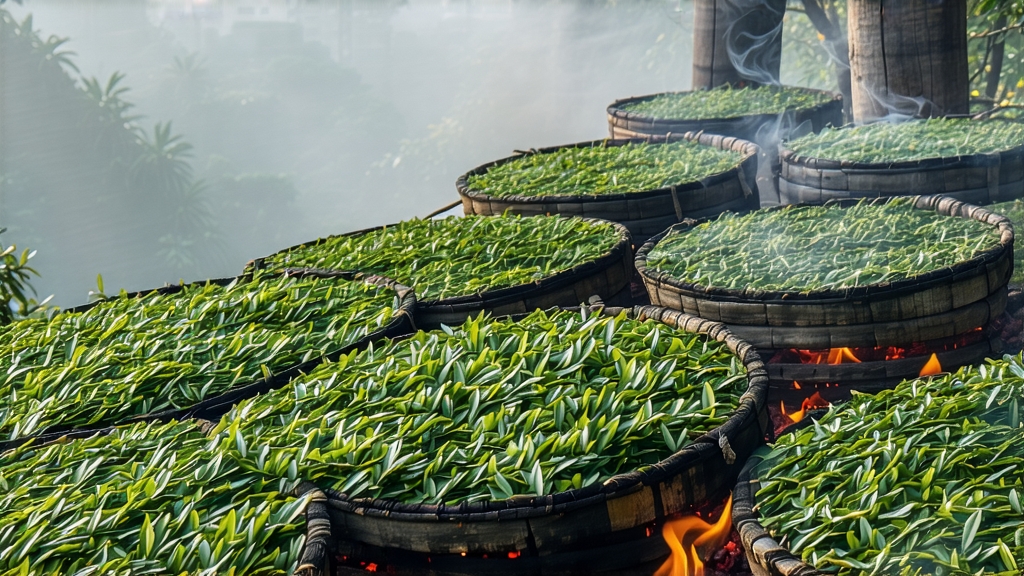
Lapsang Souchong—pronounced “lahp-sang soo-chong”—is the tea that started the global love affair with black tea. Long before Assam, Ceylon, or Earl Grey existed, this small, twisted leaf from the Wuyi Mountains of China’s Fujian province was carried across oceans by Dutch traders who christened it “bohea,” a corruption of the local place-name. Today, connoisseurs prize it for two seemingly opposite reasons: it is simultaneously the most ancient black tea on earth and the most polarizing, thanks to the unmistakable aroma of pine smoke that clings to its glossy, charcoal-black strands.
History: From Misty Gorges to London Drawing Rooms
The accepted origin story places Lapsang Souchong’s birth in 1568, late in the Ming dynasty, when a passing army requisitioned the drying sheds of tea farmers near Tongmu village. To hasten the process and keep the leaf from spoiling, the farmers spread it over pine fires. The resulting tea, far from ruined, developed a beguiling sweet-smoke character that delighted the first Canton merchants who tasted it. By the early 1600s it was being loaded onto East Indiamen bound for Amsterdam and London, where Samuel Pepys mentioned “a cup of the China drink called ‘tay’” in his 1660 diary. In the courts of Charles II, the pine perfume was considered exotic, fashionable, and—because it arrived only in tiny lots—luxurious.
Terroir: Why Only Tongmu Can Birth the Original
Authentic Lapsang Souchong is protected by both a national-origin mark and a UNESCO biosphere reserve. The core micro-zone, Tongmu Guan, sits at 27° north latitude, hemmed by 1,500-metre granite cliffs that trap humid monsoon clouds. Day-night temperature swings of 15 °C slow the growth of the indigenous Xiao Ye Zhong (small-leaf) cultivar, concentrating sugars and amino acids. The soil is a loose, acidic laterite rich in quartz and manganese, which gives the finished tea a subtle mineral spark that balances the smoke. Outside this 60-square-kilometre enclave, farmers may replicate the process, but the absence of cool mist, spring water from the Jiuqu Xi (Nine-Bend Stream), and native pine species yields a flatter, coarser cup.
Leaf Grades: Souchong, Congou, and the Rare “Wild Zheng Shan”
Within the Lapsang family, three grades dominate the export market.
- Traditional Pinewood Lapsang: the classic smoked version, made from the third and fourth leaves down the stem—older, tougher material that absorbs smoke without disintegrating.
- Unsmoked Zheng Shan Xiao Zhong: a recent innovation requested by Japanese and German buyers who wanted the honeyed malt of Tongmu without the campfire note. It is withered and oxidized in bamboo trays warmed only by charcoal embers, then baked at 80 °C to seal in cocoa and longan aromas.
- Wild Zheng Shan: picked from feral bushes growing on cliff ledges reachable only by rope. The leaves are tiny, almost golden, and yield a liquor like burgundy velvet, with natural notes of dried apricot and cedar. Annual production seldom exceeds 200 kg; most is pre-sold to collectors in Shenzhen.
Craft: Turning Green Leaf into Smoked Black
Plucking begins at dawn on the first clear day after the Qingming festival, when two leaves and a bud are still stippled with dew. The moment the basket is full, the leaf is carried downhill to the smokehouse—a two-storey wooden structure whose ground floor is lined with slate tiles. Here, pine and cypress logs from trees at least 30 years old are lit, then smothered with damp mats to create a cool, resinous smoke that drifts upward through bamboo racks. Over six hours, the leaf loses 65 % of its moisture, turning supple and olive-brown.
Next comes rolling: 25 minutes in a cast-iron trough agitated by hand until the cell walls rupture and enzymes meet oxygen. Oxidation is allowed to proceed for 2.5 hours at 26 °C and 85 % humidity, during which the leaf darkens to mahogany. The critical “kill-green” step is skipped—black tea is defined by full oxidation—so the process moves straight to second smoking. Pinewood embers are now covered with a layer of fresh